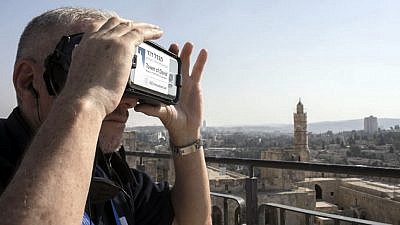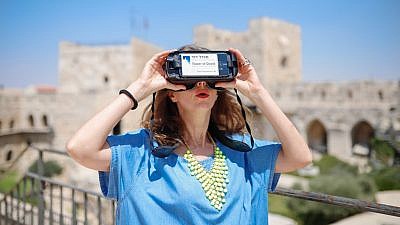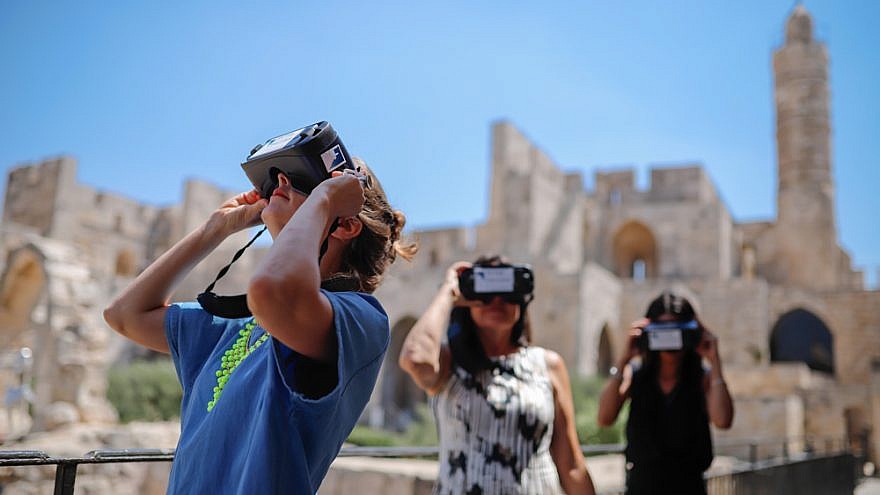One of the challenges, when walking through Jerusalem, is to picture what the city looked like through different periods of history. Now, for the first time, visitors can “step into history” with the aid of cutting-edge technology and explore Jerusalem during the time of the Second Temple 2,000 years ago.
The Tower of David Museum and the ToD Innovation Lab have teamed up with Australian company Lithodomos VR to produce the first virtual-reality mobile walking tour in Israel. It will be available to the general public starting on Sukkot, which begins on Sunday, Sept. 23.

The tour, led by a guide, takes visitors through the Tower of David Museum and then winds its way down from the ancient fortress through the Old City using virtual-reality viewpoints at the Western Wall, Robinson’s Arch, the Jewish Quarter and the Cardo to show Jerusalem today and as it was during the Herodian time period. Instead of the usual tools that a guide has at hand, such as large colored pictures, he or she can now explain the mysteries of the ancient city by simply allowing the visitors to don headsets in the right location and the magic of virtual reality fills in the missing pieces, providing the visitor with a full picture and a deeper understanding of Herod’s Jerusalem.
Virtual reality is a technology that museums such as the Tower of David Museum, visitor centers and tourist attractions are finding more and more important as a tool to innovatively engage visitors. It allows users to explore areas and time periods not limited by time, space or reality, and it captures video in 360 degrees or 3D imaging. It works by playing two separate videos into each eye that form a comprehensive video of the virtual reality, giving a perception of depth, presence and activates a sympathetic response from the viewer making them feel a part of the experience being viewed. There are two lenses in the headset that allow the user to be able to look at the content close up, enabling 360-degree 3D footage.
Eilat Lieber, director of the Tower of David Museum, is excited about the possibility that VR technology can help enhance visits to the city. “Certainly, the grandest building period in Jerusalem’s history is that which took place during the reign of King Herod. From the Second Temple to the Antonia Fortress, from the hippodrome to the theater, the public monuments, the markets and the streets, Herod’s Jerusalem was one of the greatest cities of antiquity.”
Participants on the tour are lent a Samsung Gear VR headset, and a Samsung Galaxy 7 phone and personal earphones. The tour is comprised of a series of viewpoints linked together by narrative from the tour guide and the VR content, which allows visitors to experience different aspects of socialization in ancient Jerusalem, including religious life and commercial activities.

More than 2,000 years later, said Lieber, Herod’s buildings remain integral parts of the city, with many stones still visible. In fact, she notes, “the best view of Jerusalem is still from the top of King Herod’s tower built at the Tower of David Museum. However, until now, it took a distinguishing eye and a creative mind to really imagine the city that was.”
The understanding of King Herod’s Jerusalem is particularly relevant at this time of year as Jews throughout the world prepare to celebrate Sukkot, one of the three pilgrimage festivals that are marked until this day in the Jewish calendar.
‘How deep Jewish culture runs’
This represents the first product out from the Tower of David Museum’s Innovation Lab, which was created a year ago. The lab itself is housed in one of the three towers King Herod built to guard the entrance of the city. An integral part of the museum’s activities, the lab strives at connecting visitors to the history of Jerusalem.
Together with the TOD Innovation Lab, Lithodomos VR worked together on the new tour with the Tower of David Museum bringing a beta site of visitors and a wealth of content support, and the Company Lithodomos supplying the technology, know-how and visuals. Lithodomos VR, founded in 2016 by archaeologists, artists and software developers, are establishing themselves as one of the leading suppliers of VR experiences having previously completed projects in major European cities such as Rome, Barcelona, London and Lisbon.
Working in Jerusalem, however, was an entirely different experience, according to their CEO Tony Simmons.

“Israel, especially the small parcel of land that is Jerusalem, is the single most written about, argued about and pored over piece of land in the universe,” he said. “Our work needed to be sensitive to history, ensuring that it was inclusive and not polarizing. This is also our most advance tour to date with the closest integration with Oculus, as opposed to our original app, which was for a Cardboard on a standard phone. This tour also includes GPS guidance, and narration in Hebrew and English.”
For Simmons, it was not just a business venture, but also a personal connection when it came to creating a tour in Israel. Speaking from his home in Melbourne—the city with the largest Jewish community in Australia—he said “this is something that holds great personal satisfaction, as we want the whole world to see how amazing Israel is and how deep Jewish culture runs. I want my children to see firsthand how important Israel is to me.”
For more information, visit: https://www.tod.org.il/en/discover-jerusalem-vr/.


























